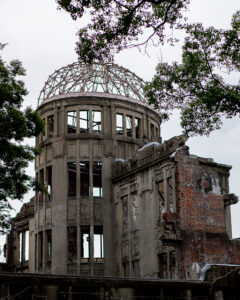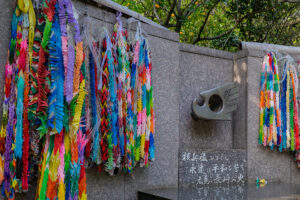Have you been to the Hiroshima Peace Memorial Park and Museum? If so, did you extend your legs to the statue of “Atomic Bomb Child” in the park? As the photo of the statue shows (above), it holds up a bronze object which is modeled after a paper crane, or “Ori-Zuru” (“Ori” and “Zuru” (or “Tsuru”) mean folding and a crane, respectively). In several storage cases near the statue, hung are many strings of paper cranes which are called “Sen-ba Zuru” in Japanese (“Sen” is for one thousand. “-ba” is a unit to count a number of birds).
Why cranes?
The model of the statue is Sadako Sasaki who died of leukemia at her tender age of 12. Her disease was diagnosed as a result of her exposure to the radiation at her age of two when an atomic bomb detonated over Hiroshima (1945). A crane had been a symbol of health and longevity in Japan for its living much longer than other animals in wilderness. So people often presented “Sen-ba Zuru” to their friends who were hospitalized with wishes for earlier recovery from the illness. Sadako Sakaki started folding paper cranes with her hope for recovery but it was not granted. After her death, what was left was several strings of one-thousand paper cranes, or “Sen-ba Zuru”. In later years, “Sen-ba Zuru” has become a symbol for people who wish peace and the elimination of nuclear weapons. People in Japan and around the world continue to send “Sen-ba Zuru” to the Hiroshima Peace Memorial Park.

It was 2016 when Barak Obama visited the Hiroshima Peace Memorial Museum as the first US president, presenting to the museum four paper cranes folded by himself. Many Japanese people were impressed with his action, understanding his sincerity for efforts to reduce nuclear weapons from the world. In 2015, out of paper cranes holded by Sadako Sasaki, her bereaved family offered one to the Presidential Library and Museum of Harry S. Truman. He is the president who approved the dropping of A-bombs on Hiroshima and Nagasaki but the offering was achieved through interchanges between the two bereaved families of Truman and Sadako.

“Sen-ba Zuru” can been seen not only in Hiroshima but in many other places in Japan. The photo above is one from Ueno, Tokyo. The strings are hung at a peace monument placed on the property of the Toshogu Shrine there. It’s a stone monument called “the Flame of Hiroshima and Nagasaki”. The source of the flame is a flame taken from the ruins in Hiroshima which were still burning after the A-bomb dropping in 1945. The flame was shared with the Ueno Toshogu Shrine and many “Sen-ba Zuru” have been offered by people who wish for peace and the elimination of nuclear weapons.
By Jin Shibata

Comment